Ethnoarchaeology
Many archaeologists are urbanites, working in countries not their own, and studying societies with an agricultural base. One excellent way for us to investigate ancient human interaction with a landscape and economy not our own is to look at how people live in that landscape today.
Using oral and other information from the present is a subfield of archaeological research called ethnoarchaeology. In this case it is important to realise 'that was then, and this is now' - i.e., that how people live now does not necessarily tell us how people lived then, but looking at the present can certainly suggest possibilities for the past that we as archaeologists might not otherwise have thought of.
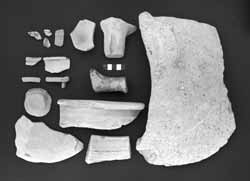 Ergastriria assemblage, including four fine wares (top left), two beehives (bottom left) and large base (basin?) (on right). © Sphakia Survey |
In our research area, Sphakia, we found many fragments of ancient ceramic beehives.
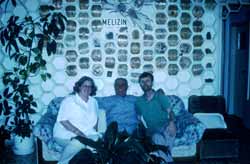 Lucia Nixon, Chrestos Zymvragoudakis, and Simon Price at the bee centre (Melizin) of Mr Zymvragoudakis outside Khania (2000) © Lucia Nixon & Simon Price |
Knowing that beekeeping was still important in the area, we set out to learn as much about it as we could. We consulted a number of people both in Sphakia and outside it, and we learnt a great deal.
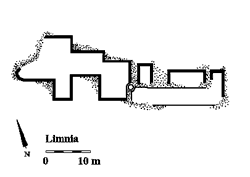 Plan of Anopolis Cistern site house. The ancient beehives were found at the E end. © Sphakia Survey |
It is well known that bees like arid areas, and that they make particularly good honey from 'arid' plants such as thyme. But we had not realised that bees do not like wind, nor that they can be kept very close to people. Thus it is possible to put beehives near to houses, which people may have done at one of our ancient sites
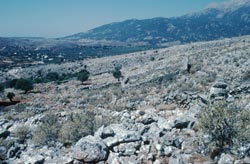 Peartree site looking W at bee enclosures above pear tree. Sept. 2000. © Sphakia Survey |
It is also possible to do what people in Crete did until about 40 years ago, which was to put hives at the top of cultivated slopes, and to protect them from wind with a wall called a bee enclosure. As this picture on the left shows, bee enclosures often included at least one tree as well as hives.
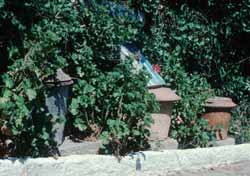 Three types of vertical beehive: tree trunk on left; basket hive in centre; ceramic on right. All three have ceramic lids. In bee centre of Chrestos Zymvragoudakis outside Khania. Sept. 2000. © Lucia Nixon |
This information we learnt from people in Sphakia. From the former Chief Beekeeper of Crete we discovered that traditional beehives on Crete were made of whatever material was easily available - wood, wickerwork, pottery.
And beekeepers in Oxfordshire gave us a possible explanation for trees in Cretan bee enclosures: they may have provided a landmark for returning bees to sight on.